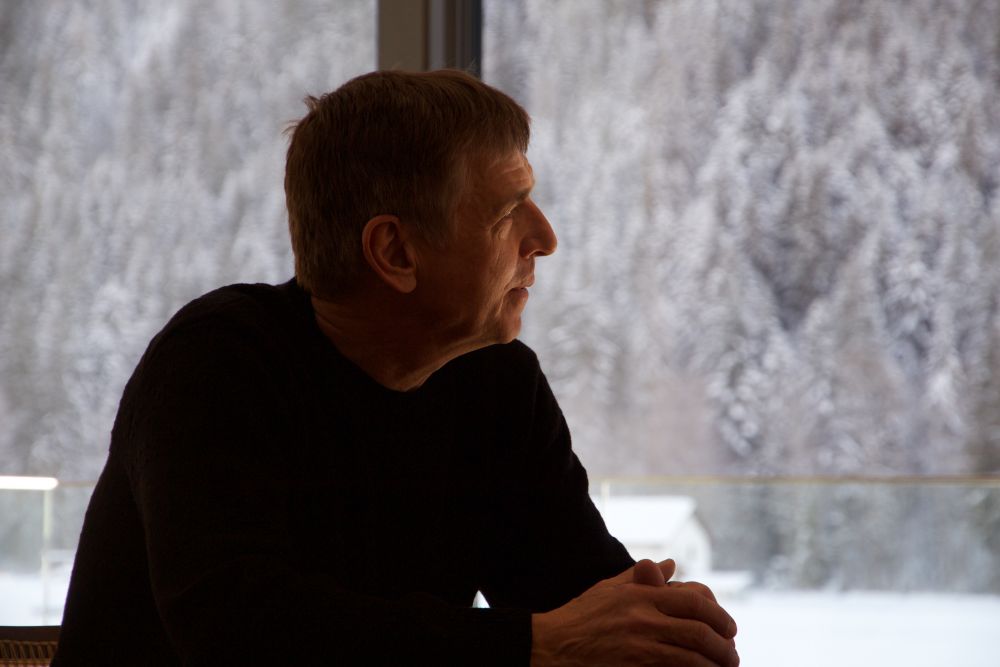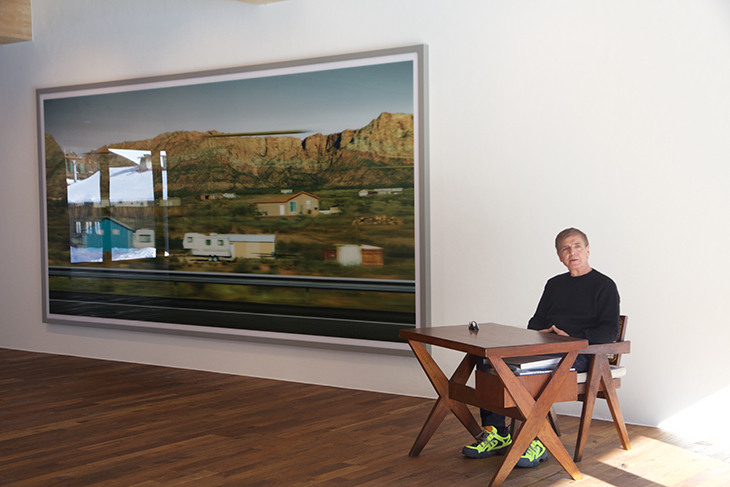

I met Andreas Gursky in the Swiss Alps in March 2019. He was holding an exhibition for Larry Gagosian on the first floor of the airport of Saanen, a small picturesque town neighboring Gstaad. I found it difficult at first, to find a common ground of communication. Being aware of his passion for electronic music, I asked if he could explain to me the secret of these sounds, which I’ve never managed to grasp or enjoy. I could feel his irritation at my question. “Everybody is allowed to listen to the music he likes” he answered with a slight exasperation. After a good 25 minutes, our conversation started to flow. I raised myself to his level and pace. He didn’t seem to have much patience for superficial small talk. His responses were slow and powerful. Bereft of embellishment and whipped cream.
As we spoke, a private jet landed. Noise and activity filled the small airport lounge, interrupting our conversation. A middle aged blond woman, teetering on high heels, wearing fur and diamonds got out of the aircraft. She was on her phone, speaking piercingly. A man small in stature followed her a few steps behind. He looked like the usual jet set tanned billionaire sporting sneakers and leather accessories. Flashes of him with champagne and prostitutes flew through my mind. I get very excited when clichés come to life. I turned enthusiastically to Andreas Gursky. “This was quite intense,” he observed. It was indeed, although Andreas Gursky hadn’t seen anything of what I had. He possibly didn’t even notice the couple. For him, the woman was sheer noise. He began describing the view in front of us. The moving mist emerging from the tar, dancing around the roaring plane. The snowy mountain backdrop against a sharp blue sky. I followed him and for a split second had the impression of having an Andreas Gursky photograph in front of me. I looked at him. His grey gaze was sharp. He was focusing on the slowly evaporating image. He had seen what most fail to notice. A magical natural landscape intersected by human activity.
Andreas Gursky shares nothing with the mundane salonnière who displaces air for attention. His phrases are spoken with directness, clarity and monotony. As if every word had matured prior to being uttered. Andreas Gursky doesn't quite fit in the usual interview frame. Publishing his responses as long monologues would be more appropriate, I believe. Here are the few selected moments I managed to withhold from our conversation in the interview frame.
***
Is there a message to be understood through your images?
I think so, but not in a one-dimensional way. I’m never trying to prove anything. I’m an image maker who deals with photography, which means, unlike painting for example, I’m necessarily connected to the contemporary world by necessity. Let’s take the piece, Amazon. If you enter an Amazon storage facility, it looks exactly like what you see on the image right?
Clearer than what one sees in reality.
Yes, of course. As I say I’m an image maker. I’m creating the image – I’m giving it a density which cannot be seen in one view. When I try to describe my work, it’s more about a condition than the content exposed. If you take my Rhein II for example, there is nothing to see. There is the water, some green in the foreground, and the background and the sky, that’s it. I’m now working on a third version of the Rhein. The structure will be the same, but the color of the water has completely changed. The saturated green has turned to yellow because of last summer’s heat wave. So it holds a there is a political statement , but never an accusation. The beauty of the image remains. Yet, , but I believe it makes one think about what is going on in our world. You know you can’t do more as an artist. If you become accusing, you are no longer doing art. Likewise, if art is understandable, it becomes boring.
Some of your recent images evoke the use of smartphone pictures
Yes, I try to open myself to new possibilities. And the iPhone is of course a serious opportunity to produce images. It’s also very attractive to me as I’m used to working with a heavy tripod and camera with extremely high resolution. My photographic captures are therefore immobile whereas with the iPhone you can react spontaneously. You always have it on you. So, I use it a lot for my notebook and then I go back to the same place but with professional materials.
 Saanen, March 2019
Saanen, March 2019
Do you use Instagram?
No. I’m too involved with my own ideas and imagination and don’t feel the need to have access to more images.
You are presently on a sabbatical, how come?
After my Hayworth show, I decided to take a sabbatical, which started last year and which I will pursue through the coming year. This means no exhibitions, no interviews. I’m just reflecting on my work, what I did and what I will do in the future.
So, you are actually working a lot?
I don’t’ know if I’m working a lot but the good thing is that I can try things which don’t necessarily need to lead somewhere. If you are under pressure for exhibitions, you lack time for reflection. Presently, I’m working on different images. And because I don’t have a time pressure to complete them, I can rethink them through and decide which direction they should lead to.
And when will your sabbatical end?
At the end of the next year (2020), I will be having an exhibition in my hometown in Leipzig. A retrospective at the Museum der bildenden Künste. It will be my first time showing in Leipzig so I want to do something really special. Also in terms of catalogues. The museum wanted me to prepare this exhibition much earlier, but I told them I needed more time.
You formed several students at the Kunstakademie of Düsseldorf which are all doing extremely well. Why did you decide to stop teaching?
I taught at the art academy for 8 years and took it very seriously. I continue to maintain close relations with my students and am interested in what they do. We are still a family. But you know, I feel like a glass, a glass which is filled till the top. I can no longer take more students. Moreover, the students I formed are now functioning amongst each other as a group. When you are an artist, it’s important to be part of a group. It enables you to have discourse and conversation on what you are doing. I had a similar experience when I studied under Bernd and Hilla Becher at the Kunstakademie of Düsseldorf. We formed a group with Thomas Struth, Thomas Ruff and others. It generated a positive form of competition. While teaching I also focused on creating a group and it worked. My students are now solid enough to go their own way.
Would it be correct to assume that there is a recognisable color or style to German contemporary art? Which is often tinted or alluding to a sublime darkness?
I see what you mean. Perhaps. There could well be a German touch in…I’m thinking of Anselm Kiefer or the Kraftwerk...Joseph Beuys.
Where does it come from?
I’d say we were all educated in a similar way. After the Second World War, everything was destroyed and had to be rebuilt. We were obliged to reconstruct our own world. It could be that this aspect transfers through a certain category of German artists, yes.
Besides doing images do you have other activities which you accomplish regularly?
I do lots of sport. Cycling, skiing, tennis, jogging, swimming. I need movement. And I sometimes practice transcendental meditation.
If you could reincarnate, choose the era, the country, the profession, – who would you be?
I feel very connected to architecture. I’m always building something, rearranging things in my studio. My friends often tell me that in my next life I’ll be an architect. So, let’s say, an architect. Our time, in Los Angeles, California.
***